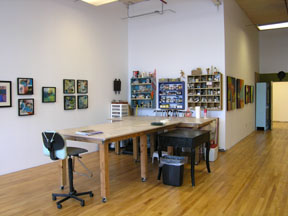 |
| The Black One, 2011, tarpaper, book covers, patinated aluminum, oilstick, encaustic, tacks, 36"x36" |
That said, sometimes I feel compelled to make works that are related to but not part of this series. These works celebrate the color black and revel in darkness. This part of my oevre precedes The Running Stitch by many years and seems to be my natural aesthetic. So here are two large works in what I have named "The Dark Series." (Click pix to enlarge.)
As far as the context and/or antecedents of this work, I think it derives from my great admiration for and study of African and African American art. This is my connection to Leonardo Drew and El Anatsui. At the same time, it relates strongly to the early work of Lee Bontecou and to Louise Nevelson, both white American artists. I believe that Bontecou's canvas work of the 1950s and 1960s was also strongly influenced by an African aesthetic as was Nevelson's.
Both The Running Stitch and The Dark Series are composed of found and invented objects in a form called "bricolage," which I have written about many times (and which is the subject of my Art of Bricolage blog). Bricolage has probably always existed and predates the use of conventional or specialized art materials. The Italian Arte Povera movement of the 1960s claimed this use of "everyday materials" for their own to "break down the dichotomy between life and art" (to quote from MoMA's statement on the topic). However, that movement did not combine the free or low cost materials in a geometric presentation, and geometry seems to be a major part of my own aesthetic and of both my continuing series.
I like this idea of having two ongoing series. It lets me feel free to experiment more. Someone recently called me a rebel, and I guess that all of us who grew up in the '60s have a rebellious outlook to some extent. That seems to have become stronger as I've grown older and witnessed the way the world threatens to break apart. It won't be long now before I'm out there on the streets occupying something, but right now I'm quite busy occupying my studio.









8 comments:
Nancy- I appreciate your speaking of your natural aesthetic, in terms of an inclination towards a darker palette. The dark pieces feel introspective and moving, and the pieces with more saturated palette are joyous explorations. But it is interesting that you feel that they form a different series. In my own work, I see myself reaching most often for a quiet and tonal palette (my own natural aesthetic) punctuated by occasional forays into brighter, more saturated and intense hues. I guess it is about expressing the complexity of who we are.
Beautiful! Keep up the good work!
Nancy, I am a long-time devotee of a reductive palette and have found black to be a particularly rich hue for expressing intellectual, psychological and emotional content. One can stretch its complexity through a range of temperatures and its capacity to simultaneously absorb and reflect light is magical to me.
Furthermore, because my African American ethnicity is an important aspect of my being, I reflexively make allusions to racial identity in my work, along with a myriad of cultural influences that conjure associative color relationships.
Thank you for discussing this topic in your blog -- acknowledging the power of blackness is a weighted choice aesthetically and politically. Highlighting the significance of African American artists' contributions to modern and contemporary art is too seldom done outside the context of exclusively black or "diversity" themed discourse. Well done!
Very interesting post, Nancy. I agree with Tamar. It does seem to me that these are "Running Stitch, Darker..." but that's subjective. As usual the work is gorgeous.
I, too, use a muted palette and I get great pleasure in mixing greys and blacks. Some people have commented on the “bleak” colors I use. To me this palette is anything but bleak; it is delicate, rich, complex, and quite beautiful.
These two pieces are lovely.
Thanks so much for your comments! Sorry that their posting and my response was delayed by my lack of internet access.
Tamar - and Lynette, in the case of my work, it's not only the palette but the variation in materials that makes the difference in my distinction between the two series. Maybe you'll think I'm splitting hairs, but I feel that the Dark Series is more about the arrangement of the elements than the content of them as it is with the Running Stitch. We'll see how it all pans out over time.
Toby, the limited palette that you have been using is striking in its simplicity and so evocative in its contrasts and harmonies. We share a devotion to the magic of black! I'm glad that you appreciated my mentioning the significance of African American artists to my own work. I think this topic calls for a more lengthy discussion and I am very interested in hearing your views. To be continued...
Tanya, thanks for your appreciation of black, too.
Cherie - I appreciate your support!
I so enjoyed both your work and this post, Nancy. More than ever, I'm anxious to see these pieces in person.
And whether you literally occupy the streets or not, you already occupy a strong position outside your studio on-line. You've made me think about more than a few points ---- concepts that this southern child-of-the-60s, who grew up in the 70s, thought she had nailed.
During the past year I too have explored the use of black in my work, something I had not done is some years. The use of black for mark making must have surely been one of the first art expressions and seems so natural. I enjoy your explorations and always find you thoughts interesting.
Post a Comment